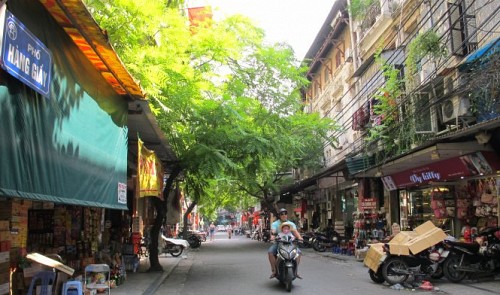The administration of the district in charge of overseeing Hanoi’s Old Quarter believes that it would be better for roads within the capital’s iconic attraction to be paved with stones, instead of the modern concrete surfaces, to live up to its reputation of antiquity.
Hoan Kiem District is seeking permission from the Hanoi administration to have 11 streets, plus their sidewalks, inside the old quarter, with a history dating back to the early 20th century, paved with “natural stones,” a proposition that has ignited objections among local residents, architects and urban planners.
The streets, which reflect the original street layout and architecture of old Hanoi, include Ta Hien, Hang Dao, Hang Ngang, Hang Duong, Dong Xuan, Hang Giay, Hang Buom, Ma May, Luong Ngoc Quyen, Hang Giay and Dao Duy Tu.
The stone-paved surfaces are meant to “ensure consistent infrastructure, boost commerce, service and tourism activities, and preserve the traditional architectural space,” according to the Hoan Kiem District administration.
If approved, the stone-paving project will be carried out between 2015 and 2016, and funded by the district’s budget.
The Hoan Kiem District administration has in fact paved part of Ta Hien Street, dubbed the city’s ‘international intersection,’ with stones since 2011 on a trial basis, and wants to do so with other streets in the old quarter, despite the negative responses to the pilot plan.
Local residents and urban planners do not think stone-paved surfaces are better than the concrete ones, as the former are more slippery, and thus more dangerous for passers-by.
The part of Ta Hien Street paved with stones has proven such inconvenience and danger.
“It is easy to see vehicles slip on the street whenever it rains,” Tran Mien, who lives on Ta Hien Street, said of the stone-paved road, speaking to The Thao Van Hoa (Sports and Culture) newspaper on Monday.
The stones get wet during rain, but emit heat when it is sunny, according to other locals.
Some urban planners said stone-paved roads are typical of European architecture and tradition, whereas Hanoi’s Old Quarter, which is a national relic site, represents a typical urban area of northern Vietnam in the past.
“So we must consider it carefully before adding any modern feature to the ancient quarter, especially when it is recognized as a national relic site,” Associate Professor Do Van Tru, general secretary of the Cultural Heritage Association of Vietnam, told the Vietnam News Agency.

























































